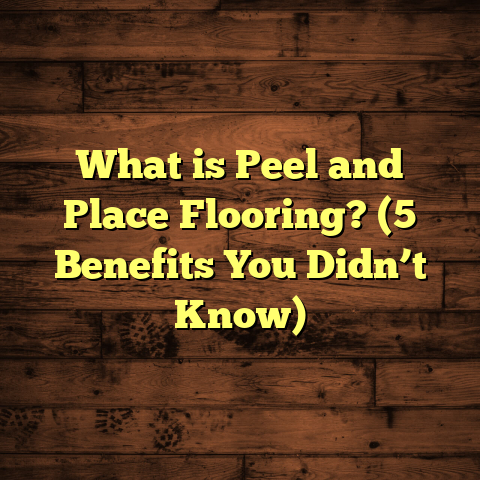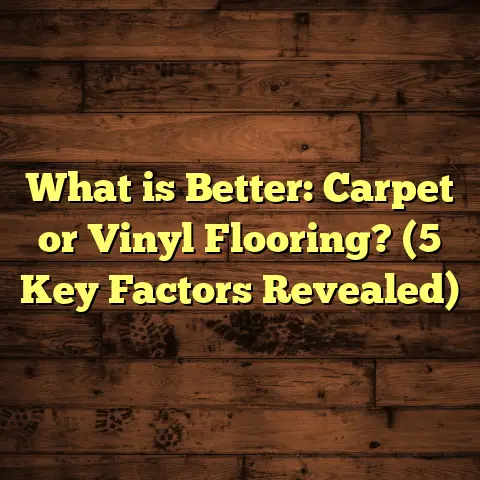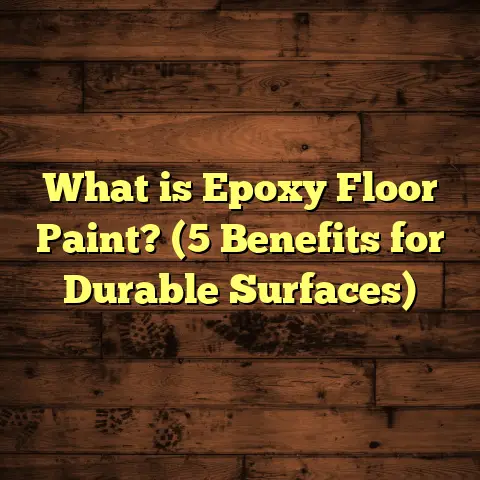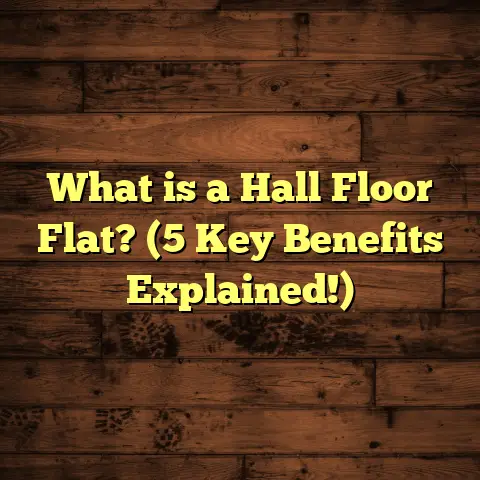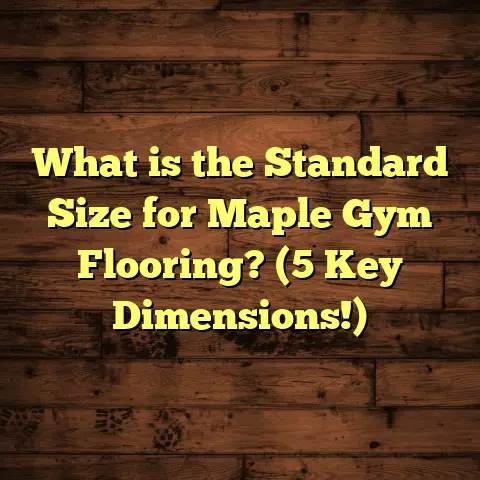What is New in Flooring Options? (5 Trends You Must Try!)
When I think about the feel and vibe of any room, the flooring always comes to mind first. It’s amazing how a floor can set the mood—whether it’s cozy warmth underfoot or sleek modern coolness. Over the years, I’ve seen flooring evolve from simple wood planks and tiles into a playground of materials and designs that invite creativity on a whole new level. The floor isn’t just something you walk on anymore; it’s a statement, a foundation of style, and a functional part of your home’s personality.
If you’re wondering what’s new in flooring options, I’m excited to share five trends that have really stood out to me. These trends combine aesthetics with technology and practicality in ways that can transform any space. I’ll break down what each trend is, why it matters, and how it might fit into your next project. Plus, I’ll share some stories and insights from my own flooring work, along with technical details and data that back up these trends.
What Is New in Flooring Options?
New flooring options are essentially the latest materials, finishes, installation techniques, and design innovations available in the market. These aren’t just cosmetic upgrades—they often bring improvements in durability, environmental friendliness, ease of care, and even installation efficiency. Flooring manufacturers continuously push boundaries by using new raw materials, refining production processes, and incorporating design trends inspired by architecture, lifestyle shifts, and technology.
For me, staying on top of these new options is important because floors take a lot of wear and tear. Choosing the right material can mean the difference between a floor that looks great for decades and one that wears out or looks tired after a few years. Plus, people’s tastes evolve. What was considered stylish five years ago might feel outdated today. So understanding what’s fresh allows me to offer clients floors that feel modern, functional, and aligned with their lifestyles.
1. Waterproof Luxury Vinyl Plank (LVP) with Enhanced Realism
Luxury Vinyl Plank (LVP) flooring has been around for quite some time but recent advances have made it a serious contender against hardwood and stone—especially for areas prone to moisture like kitchens, bathrooms, or basements.
What Makes Modern LVP Different?
The big change in LVP over the last few years is its improved look and performance. Manufacturers use high-resolution digital printing combined with embossing techniques to recreate the texture and grain of real wood or stone in a way that feels almost indistinguishable from the real thing.
The construction of modern LVP typically includes multiple layers:
- Wear Layer: This transparent layer protects against scratches, scuffs, and stains. Thickness ranges from 6 mil (light residential use) up to 20 mil or more for commercial-grade.
- Printed Design Layer: High-definition photographic layer that gives visual detail.
- Core Layer: Usually made of rigid PVC or stone-plastic composites (SPC), this layer adds stability and waterproof properties.
- Backing Layer: Provides cushioning and further water resistance.
One detail I’ve appreciated is how some LVP products incorporate enhanced UV protection to prevent fading over time—a common issue in rooms with lots of sunlight.
Why I Recommend Waterproof LVP
I’ve installed LVP floors in several homes where clients were worried about spills or humidity damaging their floors. One memorable project was a kitchen remodel where the homeowners had two kids under five—spills were frequent! The waterproof aspect gave them peace of mind without sacrificing style.
A recent report by Freedonia Group shows that waterproof vinyl flooring sales grew by nearly 35% between 2020 and 2023 in North America alone, reflecting increasing consumer confidence in this product.
Installation Notes
LVP can often be installed as a floating floor with click-lock systems, making it faster and less invasive than traditional hardwood installation. Some products are compatible with glue-down methods for extra stability on uneven surfaces.
Using tools like FloorTally helps me estimate not just material costs but also installation labor and waste factors accurately, which is critical because LVP waste can run higher on irregular rooms.
2. Sustainable Bamboo Flooring with Enhanced Durability
You might associate bamboo flooring with sustainability but also remember it as softer than hardwood or prone to dents. Well, bamboo tech has evolved! Today’s engineered bamboo floors are tougher than ever.
Strand-Woven Bamboo: What Is It?
Strand-woven bamboo is produced by shredding bamboo fibers into strands which are then compressed using high heat and pressure with adhesives. This process results in a product with a Janka hardness rating between 3000-4000—higher than many hardwoods like oak or maple.
Because of this manufacturing method:
- The floor is denser.
- It resists scratches better.
- It performs well under heavy foot traffic.
I installed strand-woven bamboo in a client’s family room where their golden retriever was notorious for scratching floors. Even after months of wear, the floor looked nearly perfect.
Environmental Impact
Bamboo grows much faster than traditional hardwood trees—mature in 3-5 years compared to decades for oak or maple. Plus, harvesting bamboo doesn’t kill the plant, allowing for sustainable regrowth.
The Forest Stewardship Council (FSC) now certifies many bamboo products ensuring responsible sourcing. Choosing bamboo can significantly reduce your home’s environmental footprint.
Finishes and Care
Modern finishes include UV-cured aluminum oxide coatings for scratch resistance and water repellency. Some manufacturers also offer carbonized bamboo options with deeper colors achieved by heat treatment.
Care is straightforward—regular sweeping and damp mopping with gentle cleaners keep these floors looking great. Avoid harsh chemicals that can degrade the finish.
Market Growth Data
According to Grand View Research, the global bamboo flooring market size was valued at $1.1 billion in 2022 and is expected to grow at over 7% annually through 2030. This increase reflects growing demand for durable and eco-friendly alternatives to hardwood.
3. Large-Format Porcelain Tiles with Minimal Grout Lines
Porcelain tile has always been popular for its durability and water resistance but big changes are happening thanks to large-format tiles.
What Are Large-Format Tiles?
Large-format porcelain tiles typically start at sizes like 24″x24″ and go up to 48″x96″ or larger. They provide a sleek look with fewer grout joints which can make rooms feel bigger and easier to clean.
Manufacturing Breakthroughs
Traditionally, thin tiles were more fragile when large. But advances like double-fired porcelain technology (where tiles are fired twice at high temperatures) create ultra-dense surfaces that can be both thin (6-8 mm) and strong.
Some manufacturers also use inkjet printing technology capable of producing realistic marble or wood patterns on porcelain creating hybrid looks that merge durability with style.
Installation Challenges & Solutions
Large tiles require perfectly flat subfloors to prevent cracking or lippage (uneven edges). Installation typically involves:
- Use of specialized leveling systems.
- Thinset mortars designed for large tiles.
- Skilled installers experienced in handling heavy slabs.
I had a project recently installing 36″x36″ porcelain tiles in an open-concept living area. The visual impact was stunning—almost seamless floor with natural stone appearance but way more practical.
Real Benefits
Fewer grout lines mean less maintenance since grout can stain or degrade over time. Porcelain is also hard-wearing against scratches, chemicals, and moisture.
Industry data from Tile Council of North America shows large-format tiles have increased market share by over 25% since 2018 due to their aesthetic appeal and performance benefits.
4. Mixed-Material Floors Combining Wood and Resin
This is one trend I find especially exciting because it blurs the line between flooring and art.
How Does This Work?
Artisans create grooves or pockets within wooden planks and pour colored epoxy resin into these spaces before sanding everything smooth. The resin can be tinted or clear, sometimes embedded with pigments or glitter for special effects.
This technique allows endless customization—from subtle color accents to bold patterns or even glow-in-the-dark effects for unique ambiance.
I once worked with a client who wanted their wedding date subtly embedded in resin strips running across their living room floor—a personal touch that guests still comment on years later.
Technical Aspects
Epoxy resin undergoes a chemical curing process where two components react to harden into a durable plastic-like material resistant to scratches and stains.
The wood must be properly sealed around the resin to prevent moisture damage or separation over time.
Cost Factors
Mixed wood-resin floors tend to be on the higher end price-wise due to labor intensity and custom nature but they offer unparalleled uniqueness.
Using FloorTally helped me estimate costs by factoring in extra labor hours for custom resin work plus special finishing materials—something traditional flooring calculators don’t usually cover well.
5. Cork Flooring Gaining Popularity for Comfort and Sustainability
Cork has always been appreciated for its softness underfoot but it’s quietly gaining ground as a mainstream flooring option thanks to new finishes improving durability.
What Makes Cork Special?
Cork comes from the bark of cork oak trees harvested without cutting the tree itself—an environmentally friendly process repeated every 9-12 years.
The cork granules are compressed into blocks or tiles using natural resins or adhesives then finished with protective coatings like polyurethane or aluminum oxide.
Comfort and Acoustic Benefits
I installed cork flooring in a home office where noise reduction was critical—the result was impressive. Cork absorbs sound better than many hard surfaces which is perfect for apartments or multi-level homes.
Plus, cork has some natural insulation properties keeping floors warmer in winter which adds comfort without extra heating costs.
Durability Improvements
Older cork floors had issues with dents and moisture damage but newer versions use enhanced coatings making them more resistant to stains, water spills, and wear.
Care remains simple: avoid abrasive cleaners and use damp mops rather than soaking water.
Market Trends
A recent analysis by Technavio projected cork flooring growth at around 6% annually through 2027 due to rising demand for eco-friendly building materials combined with consumer focus on wellness features like noise reduction.
My Personal Flooring Journey With These Trends
Let me share some stories from my experience installing these newer floor types because I think real-life examples help bring these options alive beyond just technical specs.
Case Study: Waterproof LVP in a Busy Family Kitchen
I had a client who wanted the look of hardwood but needed something kid-proof for their open kitchen/dining area. We went with a top-tier waterproof LVP product featuring a 20 mil wear layer embossed with hand-scraped oak texture.
Installation took two days thanks to the floating click-lock system—minimal disruption for their busy household.
Six months later, they reported zero damage from spills or dropped utensils despite daily chaos. The floor still looked brand new—and they loved how easy it was to clean crumbs off after meals.
Case Study: Strand-Woven Bamboo in a Pet-Friendly Living Room
Another client wanted eco-friendly flooring tough enough for two active dogs. I recommended strand-woven bamboo engineered with aluminum oxide finish for scratch resistance.
They loved how natural yet modern it looked—the deep caramel color added warmth while handling heavy paw traffic without visible scratches after nearly one year.
They noted it felt cooler than carpeting but softer than tile—which was perfect for their lifestyle balance between durability and comfort.
Case Study: Large-Format Porcelain Tiles Transforming an Open Space
A luxury condo project called for minimal grout lines across their entire living area measuring over 1200 sq ft. We specified 24″x48″ porcelain tiles printed with subtle marble veining using double-fired technology creating ultra-thin slabs strong enough for high foot traffic.
The installation crew used laser leveling tools to achieve near-flawless flatness which impressed both client and architect alike.
The owners now enjoy easy maintenance floors that visually expand their space while giving timeless elegance without coldness typical of stone thanks to radiant heating compatibility built underneath.
Case Study: Resin Inlay Floor as Custom Art Feature
One of my most memorable projects involved creating a custom resin-inlay design spelling out “Family” surrounded by geometric shapes on walnut planks for a client’s entryway.
This took weeks longer due to curing times but created an unforgettable statement floor everyone admired during house tours.
It required precise sanding techniques to blend wood and resin surfaces perfectly smooth followed by multiple sealant coats ensuring durability without losing shine or color vibrancy over time.
Case Study: Cork Flooring Boosting Comfort and Acoustics
In an apartment conversion project where noise complaints were common, we installed cork planks throughout living areas including bedrooms. The natural cellular structure of cork provided sound absorption reducing footstep noise significantly compared to neighboring units upstairs/downstairs.
The tenants appreciated walking barefoot on floors that felt warm yet firm instead of cold tiles or creaky hardwood—proving cork’s comeback potential beyond niche markets.
Technical Deep-Dive: Manufacturing Processes Behind These Trends
I often get asked what makes these new materials stand out from older options at the manufacturing level. Here’s a closer look:
Waterproof LVP Manufacturing
- Raw Material Preparation: PVC resins combined with stabilizers form the core.
- Layer Assembly: Multiple layers pressed together under heat.
- Digital Printing: High-res images applied using UV inkjet printers.
- Embossing: Mechanical rollers create textured surfaces matching printed patterns.
- Coating: Polyurethane wear layer applied for scratch resistance.
- Cutting: Precision cutting into planks/tiles ready for installation.
This layered approach allows waterproofing while maintaining flexibility needed for floating installations without warping under moisture exposure.
Strand-Woven Bamboo Manufacturing
- Harvesting: Bamboo poles cut after maturity (3-5 years).
- Stranding: Poles shredded into fibers.
- Washing & Drying: Fibers cleaned and dried.
- Binding: Fibers glued using formaldehyde-free adhesives.
- Compression: High-pressure hydraulic presses compress fibers into dense planks.
- Finishing: Sanding followed by UV-cured coatings providing scratch resistance.
This process yields boards much denser than traditional laminated bamboo which leads to superior hardness ratings around 3000+ Janka points (oak is about 1360).
Large-Format Porcelain Tiles Manufacturing
- Raw Material Mixing: Fine clays mixed with minerals.
- Pressing: Hydraulic presses form large tile blanks.
- Double Firing: First firing sinters tile; second firing densifies surface.
- Inkjet Printing: High-res ceramic inks apply realistic designs.
- Glazing & Surface Finishing: Matte or glossy finishes applied depending on design.
These methods ensure strength despite thin profiles allowing easier handling without sacrificing durability essential for residential/commercial applications alike.
Wood + Resin Floors Fabrication
- Wood Preparation: Kiln-dried planks milled with grooves.
- Resin Mixing: Epoxy components mixed; pigments added if desired.
- Pouring & Curing: Resin poured into grooves; cured chemically over hours/days.
- Sanding & Sealing: Entire surface sanded flush; sealed with polyurethane coatings.
This artisanal approach requires both craftsmanship skills plus knowledge of epoxy chemistry to avoid bubbles or bonding failures long term.
Cork Flooring Production
- Harvesting Bark: Stripped from cork oak every decade.
- Granulation: Bark granules ground and sorted by size.
- Binding & Compression: Natural resins bind granules pressed into blocks/tiles under heat.
- Cutting & Finishing: Tiles cut; multiple coatings applied including aluminum oxide/urethane finishes adding durability.
Cork’s cellular structure provides natural cushioning while coatings protect from moisture/stains extending lifespan compared to untreated cork floors decades ago.
Cost Considerations: How I Use FloorTally To Plan Projects
Estimating costs accurately is crucial because flooring budgets vary widely depending on material choice, installation complexity, labor rates, waste percentages, and location variables.
I use FloorTally regularly as my go-to tool because it consolidates these factors intuitively:
- Input local material prices based on suppliers I trust.
- Add labor costs reflecting skill level needed (e.g., complex resin work vs simple LVP installation).
- Include waste factors (especially important for cuts/waste on large-format tile or custom resin floors).
- Compare different material options side-by-side in terms of total cost per square foot including installation.
By having a realistic cost estimate upfront:
- I avoid surprises during projects.
- Clients appreciate transparent budgeting.
- I can recommend options balancing style goals against financial limits more confidently.
For example, recent projects showed waterproof LVP costing about $4-$7 per sq ft installed while strand-woven bamboo could run $8-$12 per sq ft due to material quality and finish complexity. Large-format porcelain tiles averaged $10-$15 installed given subfloor prep needs plus higher labor skill levels involved.
FloorTally’s user-friendly interface means I spend less time juggling spreadsheets—more time focusing on design details clients love!
Design Tips Based on These Trends
Thinking about how these trends fit your home? Here are some ideas:
- Use waterproof LVP in high-moisture areas like mudrooms or laundry rooms—get the look of hardwood without worry about water damage.
- Choose strand-woven bamboo for living spaces needing warmth plus pet-friendly hardness.
- Go big with large-format porcelain tiles if you want sleek minimalism—consider warm tones combined with radiant heating pads underneath to avoid coldness.
- Add personality by mixing wood planks with resin accents in entryways or feature rooms where you want visitors’ attention.
- Try cork in bedrooms or offices where noise reduction plus foot comfort matter most; pair with warm rugs if you want extra coziness.
Don’t hesitate to combine these materials thoughtfully—for example, bamboo floors flowing into large porcelain tiles at thresholds create elegant transitions between rooms while highlighting different functional zones beautifully.
Final Thoughts From My Flooring Experience
After working directly with all these new flooring types over several years across dozens of projects, I’m confident these trends are more than passing fads—they’re shaping how we choose floors going forward. Each brings unique benefits depending on your needs: whether you want eco-consciousness combined with toughness, artistic flair embedded into your floors, ultra-modern minimalism, or practical waterproof reliability.
Have you thought about what your floor says about your home? What kind of feel do you want when you step inside? Maybe one of these new flooring trends will inspire your next project—and if you do decide to make changes, tools like FloorTally can help keep your budget realistic while exploring creative possibilities without stress.
If you want any advice tailored specifically to your home’s layout or lifestyle needs—or need help understanding installation details—just ask! I’m happy to share what I’ve learned firsthand so your floors look amazing and stand the test of time too.

